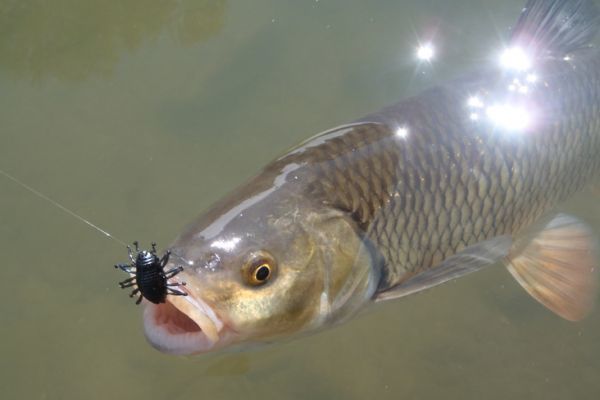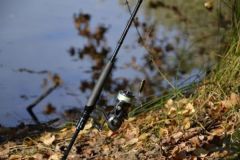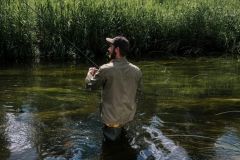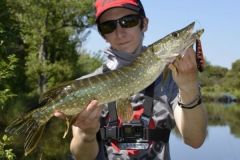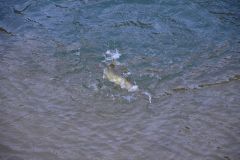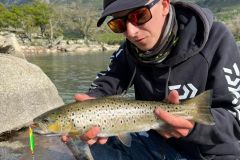The chub is a cyprinid that is very present in our waters and can reach an interesting average size. With the advent of street fishing and light fishing techniques, the chub has become a coveted sport fish. A sport fish in the truest sense of the word, as this cyprinid is sought almost solely for the thrill of fishing, or rather stalking. It's not a "noble" species, but its fighting spirit is on a par with many freshwater fish, and the adrenaline rush it provokes more than satisfies our need for sensations.
Different approaches to insect fishing
As the name suggests, the fish is presented with a soft lure imitating an insect or invertebrate.
Some brands have even developed lures for this fishery, such as woodlouse, Illex's famous insect imitation, designed and intended for chub stalking.
This is a special kind of lure fishing, in which an insect imitation is presented to the fish after it has been sighted.
This is not classic lure fishing, but rather a blend of fly fishing, surprise fishing and lure fishing. This technique is particularly suited to chub, but will also fool black-bass, asp, rotengles, perch and, more generally, all species of fish feeding on small surface prey.
The best time to use this technique is from the start of summer to the beginning of autumn. This is when fish are on the surface, looking for prey and when the water is clearest.
Sight-fishing is a dynamic type of fishing where you have to constantly scan the water as you move along the bank. You need to be attentive and move quickly but discreetly to locate as many fish as possible without being spotted, otherwise you risk spooking these wary fish or being turned away. On the other hand, it's not enough to simply cast your lure close to a spotted fish - it's a little more complicated than that.
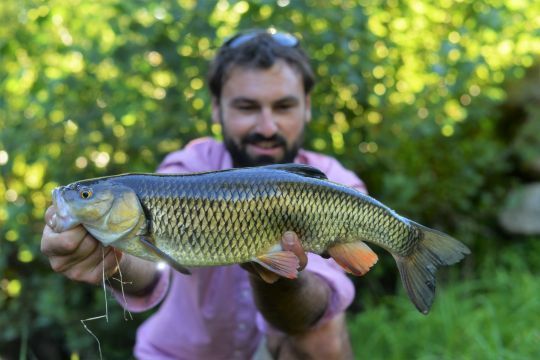
This type of fishing plays on several of the fish's reflex mechanisms. The king fish of this stalk is undoubtedly the chub. Very present throughout France, our chub, depending on its mood, will behave in several almost recurrent ways, depending on the conditions.
Without going into a systematization of his approach, it is possible to identify some trends that will help you to approach him correctly and maximize your chances of luring him.
Furthermore, these are my personal views and it's up to everyone to take advantage of these remarks and adapt them to their fishing spots and the mood of the fish.
Here are 6 cases (non-exhaustive) that I've tried to explain in a simple way in order to best approach the chub, and which in my opinion cover about 90% of sight-fishing situations.
Case 1:
The weather is sunny, with no wind (after a windy or rainy spell, or simply in fine, warm weather). Chub are very often stationary, nose to the current at a distance of between 5 and 15 m from the bank, just flapping their tail to keep still or almost still in the current.
They are also often "leaning" towards the outside of an obstacle in the water (dolphin, branch plunging into the water and trapping plant debris...).
In these conditions, the chub waits patiently for its food, which the current will bring to it without any effort on its part to catch it.
The chub hopes that the flow of water will bring it food: pieces of bread, plant debris, seeds, small invertebrates carried by the water, insects...
So we have to give him what he's been waiting for: drifting prey.
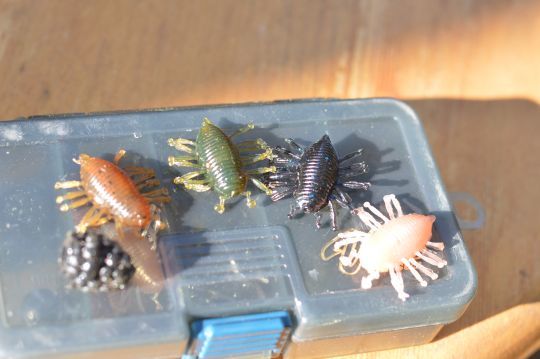
To do this, cast 3 to 5 m upstream, in line with the fish.
Laying the lure should be controlled and relatively gentle so as not to generate a large wave or noise. To do this, hold the banner taut just before the lure is cast to slow it down.
Take care to manage the banner when the lure is drifting, so that the insect and not the line arrives above the fish first. No need to animate the lure.
When the lure arrives in front of the fish, the latter just deploys its pectoral fins to climb up and seize this easy prey, taking it delicately in its white lips.
To remember: Whip cast over the shoulder or sideways with controlled, slowed landing and keep the rod up when the lure drifts.
Case 2:
Almost identical to the first, except that the light is weak (clouds, evening...) or a light breeze ruffles the surface of the water. The fish are then often no longer just below the surface, but in fifty centimetres to one metre of water. It's almost mechanical with this fish: as soon as the light diminishes or the water wrinkles, the chub descends into the water layer.
They are difficult to distinguish. Often all you can see is a dark mass or a dark caudal fin.
In this case, the prey should be suspended in the water rather than on the surface, as chub are less inclined to rise to the surface to seize prey.
For the woodlouse, pierce the air bubble and prick the hook through the lure.
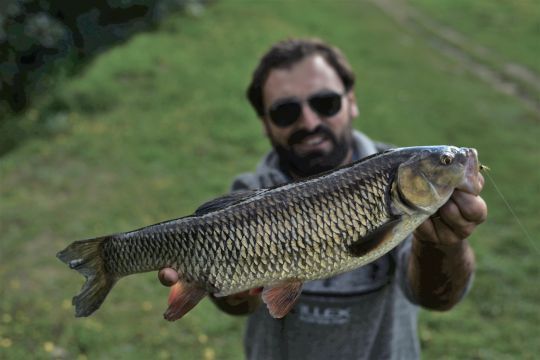
Except that the lure sinks, the strategy and method are similar to the previous case, except that the chub will shift more easily to the left or right than in a vertical plane.
To remember: Whip cast over the shoulder or from the side of the rod as the lure sinks and drifts.
Case 3:
A chub is on the edge (less than 2 m from the bank), motionless or in an area (not necessarily in the immediate vicinity of the bank) where there is very little current. It doesn't wait for prey to drift away, but rather lies in wait, often under foliage, fruit trees or along a structure.
It usually waits for terrestrial prey to fall into the water. Here again, you have to offer the chub what it covets: a clumsy prey that falls into the water.
You'll need to cast in front of the fish (between 1 m and 2 m in front) or ideally between the fish and the bank, making sure that the banner doesn't pass over the fish - it's important!
The more noise your lure makes as it falls into the water (a "plop"), the more interesting it will be and the more it will capture the attention of our cyprinids. In this case, lures in dark shades are often the best (imitating fruit or insects).
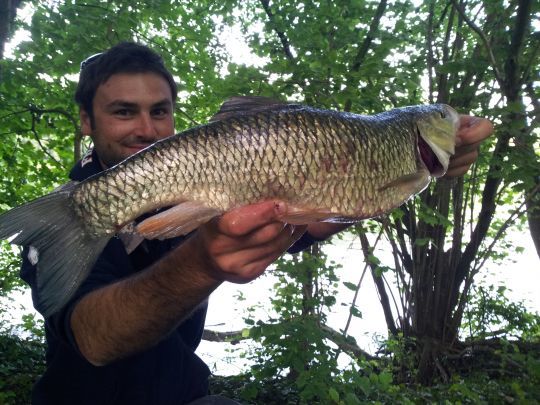
Sometimes you'll even have to skipper (ricochet your lure) to flush out the chub. The chub can either run up to the lure, slow down a few centimetres from it and rise delicately to seize it (easy strike), or seize it violently in a big eddy (more difficult strike, and don't hesitate to wait almost a second after the eddy to strike and make sure the chub has seized our "beast").
To remember: Cast under the closing rod of the fast pick-up to be reactive on the strike, don't hesitate to make a "ploc" when the lure falls to attract the attention of the cyprin on the look-out
Case 4:
A chub moves more or less quickly, but not at the same depth. The fish is not necessarily feeding, and its great mobility prevents accurate casting.
You have to surprise it! Try to cast as close as possible to the fish, taking care not to let the line pass over the chub. The chub will most likely reflexively and mechanically pounce on your lure!
To remember: Quick cast on the fish
Case 5:
There are several schooling chub. The fish are competing for food and are therefore less wary. First on the food, first served.
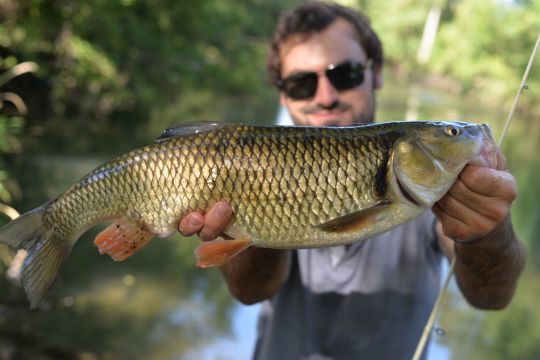
Rather than throwing randomly into the pile, try to throw as close as possible to the most beautiful subject...
To remember: throw according to bench distance.
Case 6:
A case I've rarely taken advantage of, but one that's nonetheless conducive to chub fishing. These are insect hatchings on lakes. Several species of fish (salmonids, rotengles, roach, even perch and, of course, chub) gobble on the surface.
I didn't necessarily fish by sight, but cast close to a wave created by a gobbling action and betraying the presence of a fish.
I animated my insect lure with very slight tremors, to imitate an agitated invertebrate disentangling itself from the liquid element.
For this, a rod with a rockfishing or street fishing style and a full tip is ideal for micro-animating your lure. Gobbles on your lure often occur after a few seconds of movement.
To remember: cast close to a gobble then animate the lure with slight tremors.
These six different cases are designed to help you in your approach to sight-fishing for chub. Of course, you'll need to adapt to the conditions (crosswinds, abundance of a particular type of food, presence of structure, depth of the stream...), but also to the mood of the fish, which can sometimes be very stubborn.
What all these cases have in common is that, initially and by default, I don't animate the lure (except case 6). On the other hand, if the lure refuses, I use micro-shakes and vibrations (using a rod with a full tip) to trigger the attack. It's not uncommon for the "mutt" to make a loop and come back to snatch our insect imitation that it had abandoned on the first pass.
